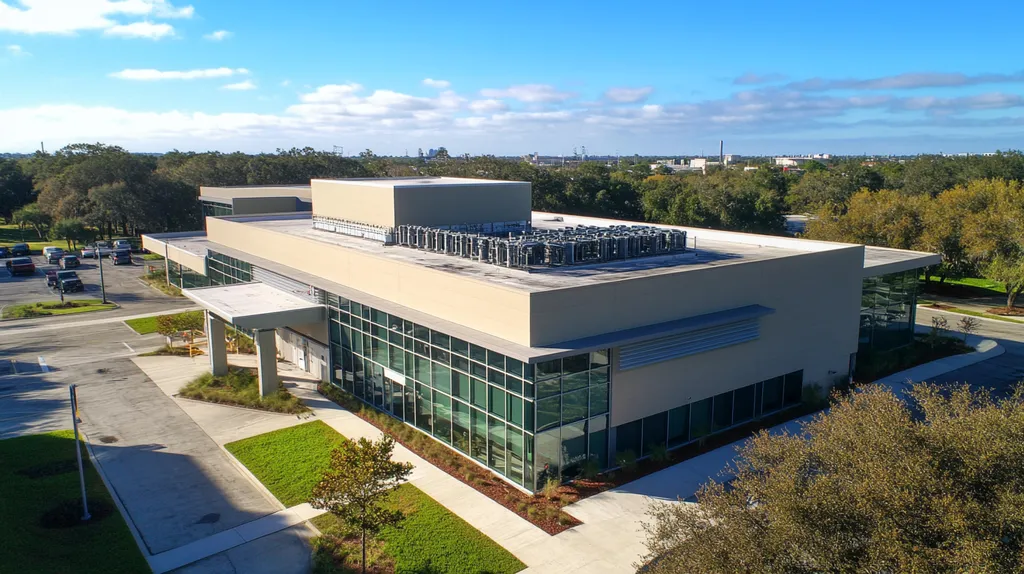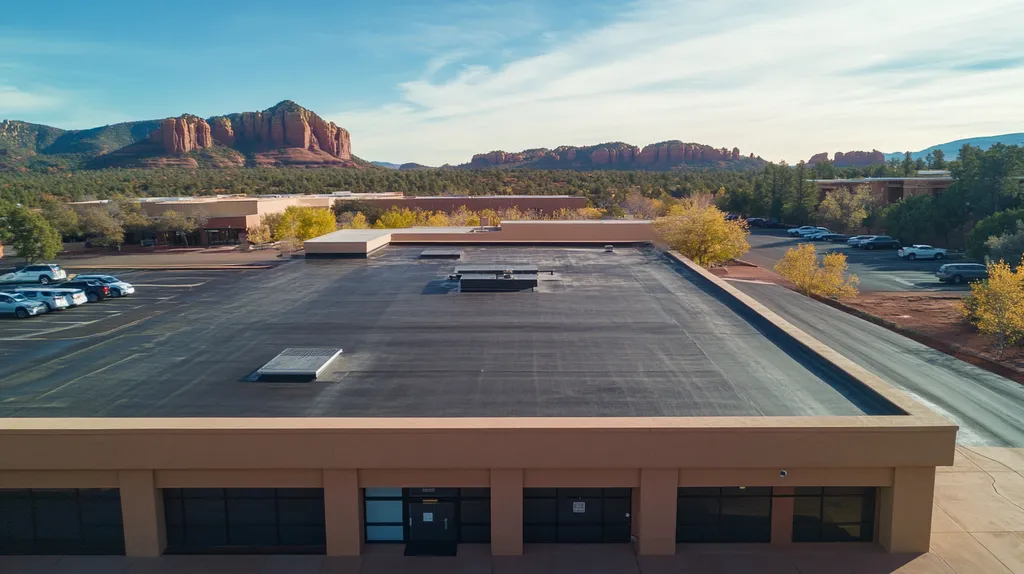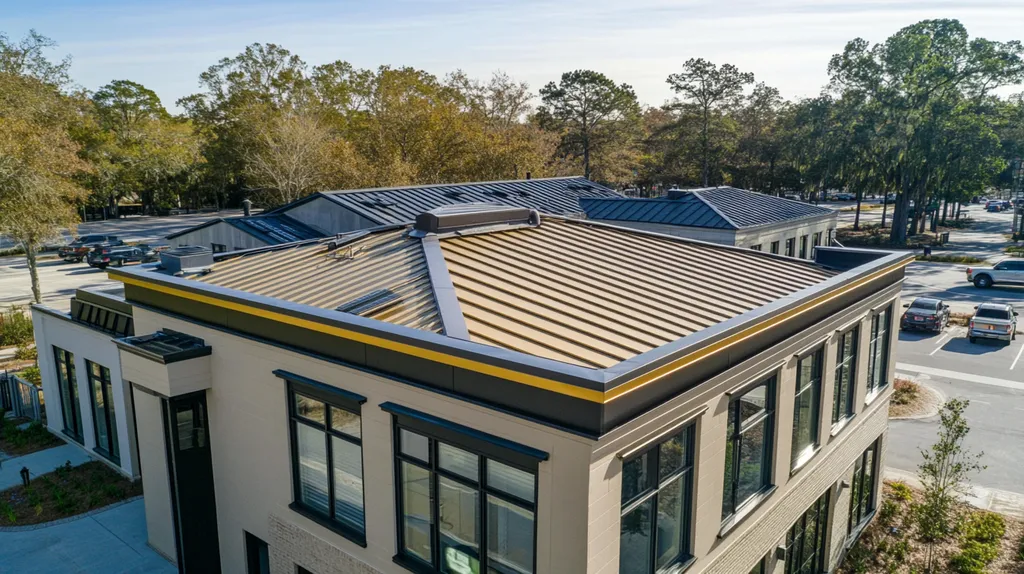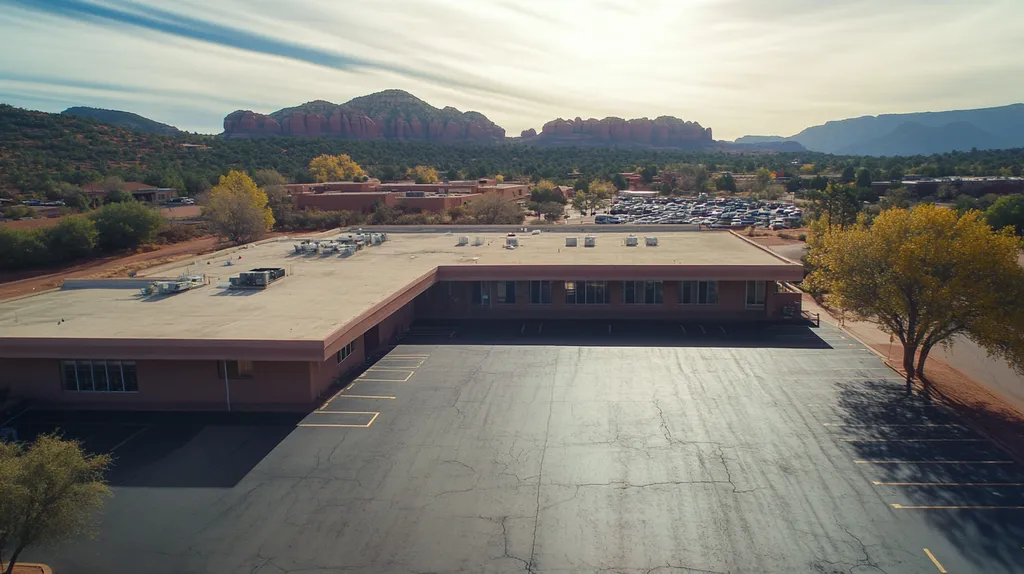In commercial roofing, up to 90% of costly water damage can be traced to a single critical failure point: improperly detailed flashing around roof penetrations. These vulnerabilities threaten not just the structural integrity of buildings, but also millions in assets housed within.
From HVAC systems to plumbing stacks, every penetration through a commercial roof creates potential pathways for moisture intrusion that must be properly managed through precise flashing details.
This comprehensive guide examines the materials, techniques, and maintenance requirements essential for creating watertight seals at roof penetrations, helping property owners protect their investments through proper flashing implementation.
SECTION 1: FUNDAMENTAL CONCEPTS
Commercial roofing systems serve as the protective shield for businesses, but their effectiveness hinges on understanding flashing details. Alarmingly, nearly 90% of roof leaks can be traced back to inadequate flashing around penetrations. This underscores the necessity of grasping flashing principles, recognizing different types of penetrations, and implementing effective waterproofing strategies to ensure the durability and dependability of commercial roofs.
Definition and Purpose of Roof Flashing
Roof flashing is an essential element that helps to guide water away from critical parts of the roof. When flashed correctly, it creates a robust barrier around areas where the roof surface is interrupted, such as vents and pipes, ensuring that water can’t seep in and cause damage. Different types of flashing are needed for various roof shapes and materials, making these components vital to any effective roofing solution.
Flashing plays multiple roles; it prevents unwanted water intrusion, promotes moisture management, and extends the lifespan of the roofing system. Placed strategically around pipes, vents, and other fixtures, it guards these vulnerable points where water could accumulate. Recognizing the purpose of flashing empowers property owners to appreciate its impact on overall roof performance.
When installed correctly, flashing not only averts leaks but also safeguards the building’s structure from potential moisture damage. The result is reduced maintenance costs and a longer lifespan for the roofing system as a whole. Failure to use proper flashing can have detrimental long-term consequences that property owners cannot afford to overlook.
Types of Roof Penetrations in Commercial Buildings
Commercial roofs typically encounter several types of penetrations, including HVAC systems, vents, plumbing stacks, and skylights. Each of these features introduces special challenges regarding waterproofing and maintenance. For instance, HVAC units have complex ductwork that must be properly sealed and flashed to mitigate the risk of moisture intrusion.
Plumbing stacks penetrate the roof’s surface and require durable flashing solutions to handle varying temperatures and natural movement. Skylights, which provide natural light, also need meticulous detailing during installation to prevent leaks. Understanding these different types helps property owners implement effective strategies for managing their roofing systems.
The greater the number of penetrations on a roof, the higher the potential for leaks if they aren’t properly addressed. Thus, property owners should take a proactive approach to both the installation and maintenance of these features to ensure a robust waterproof barrier. Being aware of the types and challenges related to roof penetrations is critical for effective roof management.
Importance of Waterproofing at Penetrations
Waterproofing should be a top priority at roof penetrations, where failures can lead to serious structural damage. A leak not only threatens the building itself but also jeopardizes the contents within, resulting in expensive repairs and possible business downtimes. Therefore, implementing solid waterproofing measures is crucial for safeguarding both the structure and its functionality.
Each penetration needs to be treated with high-quality waterproofing products to ensure that water is redirected away from critical areas. Products like specialized sealants and membranes can significantly enhance resistance to leaks. Employing proper installation techniques, including layering and sealing, adds an extra layer of protection against potential failures.
Regular inspections and maintenance are vital to keeping waterproofing measures effective over time. Factors such as weather changes and natural building movement can weaken seals, making consistent upkeep necessary. By prioritizing waterproofing at these vulnerable points, property owners can drastically lower the risk of costly water damage and ensure the integrity of their roofing systems.
SECTION 2: SYSTEM COMPONENTS
When it comes to commercial roofing, selecting the right materials and designs for roof penetration flashing is a game-changer. Poorly designed or installed flashing can lead to disastrous leaks, structural breakdowns, and financial burdens for property owners. A staggering finding from the National Roofing Contractors Association shows that more than 50% of roofing failures arise from inadequate detailing around penetrations. Addressing these concerns with the right flashing components can dramatically enhance both the lifespan and efficiency of a roof.
Materials Used for Roof Penetration Flashing
The materials chosen for roof penetration flashing are pivotal in ensuring effectiveness. Typical options include aluminum, copper, and galvanized steel, each offering distinct advantages regarding durability and resistance to the elements. For example, aluminum is lightweight and highly resistant to corrosion, making it an excellent choice for areas prone to harsh weather.
Furthermore, flexible membranes like EPDM and TPO are crucial for navigating the complexities of various penetrations. These membranes form a watertight seal, especially when installed correctly to fit the unique shapes of different fixtures. The right blend of materials not only improves their functionality but also extends the overall life of the roofing system.
Moreover, industry regulations emphasize the need for material compatibility with existing roofing systems. Choosing materials that clash with the roof type can lead to future failures and increased repair costs. Familiarity with each material’s properties is essential for ensuring seamless integration into the roofing system.
Ultimately, making informed choices about flashing materials directly impacts the management of roof penetrations. High-quality options minimize risks and enhance long-term performance in commercial roofing applications.
Compatibility with Roofing Systems and Materials
Establishing compatibility between flashing and roofing materials is critical for achieving optimal performance. Different roofing systems—such as built-up roofs (BUR), single-ply membranes, or modified bitumen—require specific flashing types to function effectively. For illustration, thermoplastic roofing systems thrive when paired with welded flashing solutions.
Additionally, the design of flashing must consider the thermal expansion and contraction of the roofing materials. Incompatibility can create stress points that lead to leaks over time. Recognizing these elements enables property managers to make empowered decisions regarding flashing installations.
A thorough evaluation of the existing roofing materials is essential before applying flashing. Consulting with roofing professionals can help clarify compatibility issues and assist property managers in selecting appropriate solutions. This is vital for preserving warranties and adhering to industry standards.
Ensuring that materials work well together simplifies installation and bolsters the overall integrity of the roof. Strong compatibility helps mitigate future complications and contributes to a longer-lasting roofing system.
Customized Flashing Designs for Unique Penetrations
Commercial roofs often present unique challenges, especially at points where pipes, ducts, or vents penetrate the structure. Customized flashing designs can effectively cater to these specific requirements, dramatically improving water management. Generic flashing solutions may fail to protect against leaks in complex configurations.
Custom designs can be created using prefabricated components or fabricated on-site for a precise fit. This approach ensures that flashing effectively seals around challenging penetrations, especially those with unusual shapes or varying heights. Well-executed custom flashing significantly reduces the risk of moisture intrusion.
Incorporating features like secondary drainage channels can further enhance the performance of customized flashing. These additional elements provide extra protection against water backups and ensure efficient runoff during heavy rainfall, safeguarding both the roof and the underlying structure.
In summary, tailored flashing options greatly elevate the effectiveness of protecting roof penetrations. Thoughtful design considerations lead to significant leak reductions and preserve the integrity of the roofing system throughout its lifespan.
SECTION 3: IMPLEMENTATION METHODS
Proper implementation of flashing techniques is crucial for maintaining the integrity of commercial roofs. With nearly 70% of roof leaks stemming from poorly installed or neglected flashing, it’s essential for property owners and facility managers to take this issue seriously. Key factors to focus on include following correct installation procedures, adapting flashing techniques for specific features such as chimneys and vents, and ensuring seamless integration with existing roofing and wall systems. Addressing these elements can dramatically enhance roof performance and longevity.
Installation Procedures for Step Flashing
Installing step flashing requires precision to create an effective waterproof barrier at the junction of walls and roofs. Each piece should be staggered, allowing water to flow downward and away from the roof surface. This method helps prevent leaks by ensuring a strong defense against rain and moisture.
Proper nailing techniques are also paramount; nails need to penetrate through the overlapping sections of the flashing. This practice secures the flashing while preventing water from seeping through nail holes. Careful alignment and spacing of each layer are vital for comprehensive coverage.
Applying high-quality sealants at the seams can offer additional protection. It’s important to choose sealants that can endure temperature fluctuations and UV exposure. Conducting routine inspections after installation allows for early detection of potential weaknesses, helping to maintain a watertight seal.
By diligently following these procedures, property owners can extend the lifespan of their roofing system and minimize future repair costs.
Flashing Techniques for Chimneys and Vents
Chimneys and roof vents are key areas where effective flashing can safeguard the entire roofing system. For chimneys, combining counter-flashing and step flashing is best practice. This dual strategy reinforces the waterproof barrier at the chimney base while protecting the underlying roofing material.
The counter-flashing should be integrated into the masonry of the chimney, creating a seamless seal. When done correctly, this prevents water from infiltrating the vulnerable joints between the chimney and roof.
For vents, using a prefabricated flashing kit can streamline the installation process. These kits often come with clear instructions to help avoid common mistakes, such as inadequate sealing.
Roofing professionals should consistently check that the flashing aligns with the overall slope of the roof. Ensuring proper drainage is essential to prevent water pooling, which can compromise the roofing materials over time.
Integrating Flashing with Roofing and Wall Systems
A successful integration of flashing with roofing and wall systems is vital for effective water management. The junction between different materials can become a weak link if not properly addressed. Continuous flashing designs ensure that rainwater flows over roofing materials and away from the structure.
The installation should align flashing with the roof deck and any wall membranes. Evaluating key intersections during installation helps determine the best materials that complement both the roofing and wall systems.
Choosing weather-resistant materials enhances performance. For example, pairing metal flashing with a membrane roofing system creates an excellent water barrier that can withstand the elements.
Ongoing maintenance is equally important; regular inspections allow property owners to identify any wear and tear on the flashing and roofing materials. Timely interventions can prevent small issues from escalating into costly repairs.
In conclusion, a well-executed integration process not only enhances the waterproofing capabilities of the roof but also extends its lifespan, ensuring the structural integrity of the building.
SECTION 4: MAINTENANCE REQUIREMENTS
Ignoring the maintenance of flashing details can lead to critical roofing problems, such as leaks and structural damage. Alarmingly, around 30% of roofing failures are attributed to poorly maintained flashing. Routine upkeep is essential to safeguard the integrity of commercial roofs and stave off expensive repairs. This section outlines essential maintenance requirements for flashing, covering inspections, common issues, and effective repair practices.
Regular Inspection and Monitoring of Flashing
Regular inspections of flashing are vital for prolonging the lifespan of a commercial roof. It’s recommended that property owners carry out thorough checks at least twice a year, ideally during spring and fall. These evaluations help in spotting wear and tear, allowing for timely interventions before minor issues escalate.
In addition to seasonal inspections, post severe weather monitoring is crucial. Heavy rain or strong winds can loosen flashing components, leading to potential water intrusion. Keeping a detailed log of inspection findings can illuminate patterns over time and aid in refining maintenance schedules.
When inspecting, focus on seams and transitions where different materials meet, as these spots are particularly prone to deterioration. Look for signs of rust, cracks, or gaps, and take immediate action if any issues arise to maintain roof integrity.
For hard-to-reach areas, consider utilizing drone technology. Drones can capture clear images and video footage, making it easier to assess conditions without relying on scaffolding or ladders.
Identifying and Addressing Common Issues
Common flashing issues include poor installation, corrosion, and separation from the underlying structure. Early detection of these concerns can save property owners considerable costs. For example, inadequately fitted flashing may allow water to breach the roof membrane, causing detrimental leaks.
Corrosion is particularly problematic in areas with metal flashing. Factors like humidity and exposure to chemicals can hasten deterioration. Regular cleaning of flashing surfaces can help mitigate these risks and prolong the material’s lifespan.
Separation from the roofing system can result from environmental impacts or aging materials. Monitoring for any signs of separation is essential; if detected, it should be addressed promptly. Gaps might be sealed, but more extensive repair or replacement could be required for a long-lasting solution.
It’s also important to be vigilant about nearby rooftop installations like HVAC units. Clear communication with maintenance teams regarding these systems can prevent potential damage during their operation.
Scheduled Maintenance and Repair Best Practices
Implementing a scheduled maintenance plan is crucial for ensuring the durability of flashing details. This plan should include regular inspections, cleaning, and repairs tailored to the specific materials in use. A systematic approach significantly reduces the likelihood of unexpected failures.
During repairs, always use high-quality materials specifically designed for roofing applications. Cutting corners with inferior products can result in premature failures and added expenses. Investing in premium sealants and flashing materials enhances both waterproofing and longevity.
Documenting all maintenance actions creates a comprehensive record, aiding in future planning and providing necessary documentation for insurance or audits. Regularly updating this log will also help track the condition of the flashing over time.
Finally, consider enlisting a qualified roofing contractor for complex repairs or inspections. Their expertise can provide an extra layer of assurance that the roof will perform as intended, protecting the property’s value and the safety of its occupants.
SECTION 5: PERFORMANCE METRICS
The performance of a commercial roof hinges significantly on the quality of its flashing details. Ineffective flashing can lead to expensive leaks, threatening not only the roof’s structural integrity but also compromising the safety of its contents. Alarmingly, over 60% of roofing failures can be linked to improper flashing installation. This section evaluates critical performance metrics—including water tightness, durability, and adherence to building codes—that influence the effectiveness and reliability of flashing systems.
Evaluating Water Tightness and Leak Resistance
Water tightness is the cornerstone of effective flashing around roof penetrations. Even the smallest breach in this seal can spiral into considerable water damage. To assess the integrity of these flashing installations, testing methods like spray tests and flood tests are invaluable—they simulate real-world conditions to measure leak resistance.
For instance, in commercial buildings where HVAC systems penetrate the roof, it’s vital that flashing channels water away effectively. Using continuous flashing techniques during installation can enhance resistance to leaks and keeps the interior dry.
Regular inspections should focus on identifying signs of degradation, such as rust or cracks, which compromise the seal. Developing a proactive maintenance plan can help address these vulnerabilities before they evolve into serious issues, ultimately shielding property owners from costly repairs.
By understanding how water tightness is measured, property owners can make informed decisions regarding their roofing systems, enhancing their protection against future leaks.
Assessing Durability and Longevity of Flashing
Flashing materials must be durable to ensure effective long-term performance. Common options like lead, copper, and modified bitumen offer varying degrees of resilience depending on environmental conditions. Selecting the right material is crucial, especially for regions prone to harsh weather or high winds.
For instance, areas experiencing extreme weather demand more robust flashing solutions to resist wear and tear. Manufacturers often provide performance data, guiding property managers in choosing optimal materials appropriate to specific scenarios.
Conducting periodic reviews of flashing conditions helps in identifying wear and tear early. Investing in high-quality materials with warranties can assure performance and longevity across diverse weather conditions.
In the long term, durable flashing not only protects the overall roof but also contributes to significantly lower maintenance expenditures over time.
Compliance with Local Building Codes and Standards
Adhering to local building codes and standards is essential for the installation of flashing details. These regulations are in place to ensure safety and optimal performance; non-compliance may lead to costly penalties or even void warranties. Additionally, installations that fall short of code can complicate insurance claims.
Many cities require specific details concerning flashing around penetrations, including height specifications and sealing methods. Property owners should familiarize themselves with local codes to ensure their flashing installations meet all necessary requirements.
Working with licensed roofing professionals can facilitate compliance and ensure the highest standard practices during installation. These experts are experienced in the latest code updates and can provide essential guidance.
Prioritizing compliance not only mitigates legal risks but also guarantees that the flashing contributes effectively to the overall performance of the roofing system.
SECTION 5: PERFORMANCE METRICS
The integrity of a commercial roof is fundamentally tied to the quality of its flashing details. Inadequate flashing can result in costly leaks, which jeopardize not only the building’s structural integrity but also the safety of what lies within. Industry statistics reveal that over 60% of roofing failures stem from improper flashing installation. This section delves into crucial performance metrics, including water tightness, durability, and compliance with building codes, all of which play a vital role in determining the effectiveness of flashing systems.
Evaluating Water Tightness and Leak Resistance
Water tightness is the cornerstone of effective flashing around roof penetrations. A single lapse in this protective seal can lead to significant water damage, threatening both the structure and contents of the building. Testing methods, such as spray tests and flood tests, simulate real-world conditions to assess the effectiveness of flashing installations.
For example, commercial roofs with HVAC system penetrations must ensure that flashing channels water away efficiently. Using continuous flashing techniques during installation enhances water resistance and prevents leaks from occurring.
Regular inspections should focus on identifying signs of wear, such as rust or cracks, which can compromise leak resistance. Establishing a proactive maintenance plan allows for addressing vulnerabilities before they escalate into serious issues.
Ultimately, understanding how water tightness is evaluated enables property owners to make informed decisions regarding their roofing systems, allowing for protection against future costly repairs.
Assessing Durability and Longevity of Flashing
The durability of flashing materials significantly impacts both effectiveness and longevity. Common materials such as lead, copper, and modified bitumen offer varying levels of resilience, particularly under challenging environmental conditions. Selecting the right material is crucial, especially for regions exposed to harsh weather or high winds.
For instance, areas prone to extreme weather require robust flashing solutions that can withstand the elements. Manufacturers often provide performance data to guide property managers in selecting the most suitable materials for their specific scenarios.
Conducting routine evaluations of flashing conditions helps identify wear and tear early on. Investing in high-quality materials with warranties ensures that they can endure diverse weather challenges.
In the long run, durable flashing not only extends the roof’s life but also leads to reduced maintenance costs, enhancing overall roof performance.
Compliance with Local Building Codes and Standards
Adhering to local building codes and standards is essential for the installation and operation of flashing systems. These regulations ensure performance and safety; non-compliance can lead to costly penalties or voided warranties. Moreover, installations that fall short of code can complicate insurance claims should issues arise.
Many jurisdictions mandate specific flashing details around roof penetrations—including height specifications and sealing methods. Property owners should familiarize themselves with these local codes to ensure compliance during installation.
Engaging with licensed roofing professionals not only supports adherence to building codes but also ensures that best practices are followed throughout the installation process. These experts are typically up-to-date on the latest requirements and can offer invaluable guidance.
Ultimately, prioritizing compliance with building codes helps mitigate legal risks while enhancing the overall performance of roofing systems, ensuring effective protection against the elements.
The Bottom Line
With up to 90% of commercial roof leaks traced to faulty flashing around penetrations, the stakes for proper detailing could not be higher.
Property owners face potential damages in the millions when water intrusion compromises not just the building structure, but also expensive equipment, inventory, and business operations housed within.
The integration of proper materials, precise installation methods, and regular maintenance creates a robust defense against these risks.
By implementing comprehensive flashing strategies that incorporate advanced materials, proven techniques, and systematic inspections, facility managers can dramatically extend roof lifespan while protecting their valuable assets.
The future of commercial roofing depends on treating penetration flashing not as an afterthought, but as a critical component demanding meticulous attention and expertise.
FREQUENTLY ASKED QUESTIONS
Q. How do flashing details impact commercial roof performance?
A. Flashing details are crucial for defending against water intrusion in commercial roofs. Proper installation prevents leaks, which can lead to significant water damage and costly repairs. Understanding flashing principles helps ensure a durable roof that meets performance expectations.
Q. What materials are best for industrial roof penetration flashing?
A. The best materials for flashing include aluminum, copper, and galvanized steel due to their durability and corrosion resistance. Flexible membranes like EPDM and TPO are also important for ensuring watertight seals around various penetrations. Choosing appropriate materials enhances long-term roof effectiveness.
Q. How can I ensure proper installation of flashing on my commercial roof?
A. Ensuring proper flashing installation involves following precise installation procedures, adapting techniques for specific features, and integrating flashing with existing roofing. Engage professionals when necessary to improve reliability and reduce the risk of future issues.
Q. Why is regular maintenance critical for commercial roof flashing?
A. Regular maintenance is vital as it helps identify and address issues early, thus preventing leaks and structural damage. Scheduled inspections can prolong the life of the roof and reduce overall repair costs, making them essential for effective roof care.
Q. How do I evaluate the leak resistance of my roof’s flashing?
A. To evaluate leak resistance, conduct spray or flood tests to simulate water exposure. Regular inspections focused on detecting signs of wear, such as rust and cracks, also help ensure the flashing remains effective and protects the roof.
Q. What role do building codes play in flashing installations?
A. Building codes are crucial in ensuring that flashing installations meet standards for safety and performance. Non-compliance can lead to costly penalties or void warranties, making it important to understand and adhere to applicable codes during installation.
Q. What is the importance of custom flashing designs for unique penetrations?
A. Custom flashing designs are essential for effectively sealing around unique roof penetrations, reducing the risk of moisture intrusion. Tailored solutions ensure that flashing properly fits various configurations, providing optimal protection against leaks and extending the lifespan of the roofing system.










